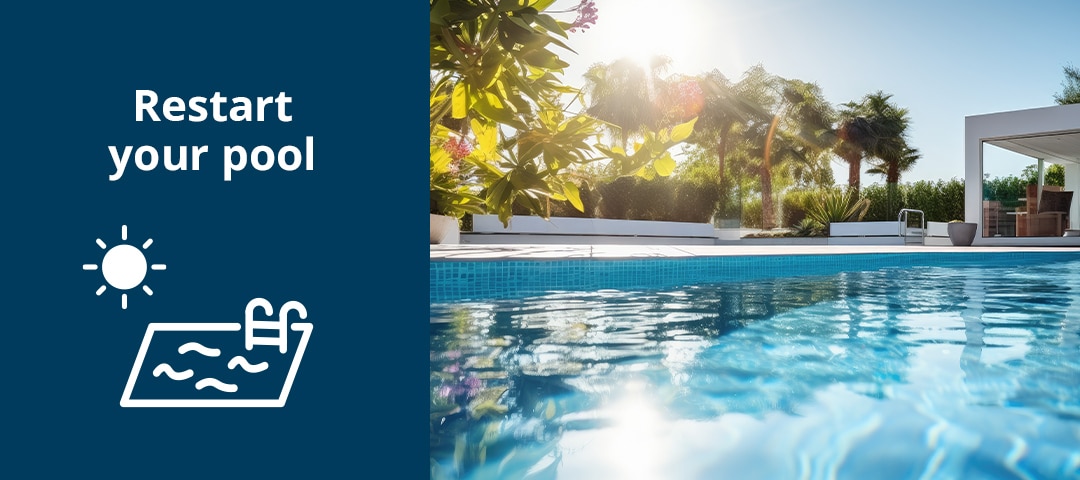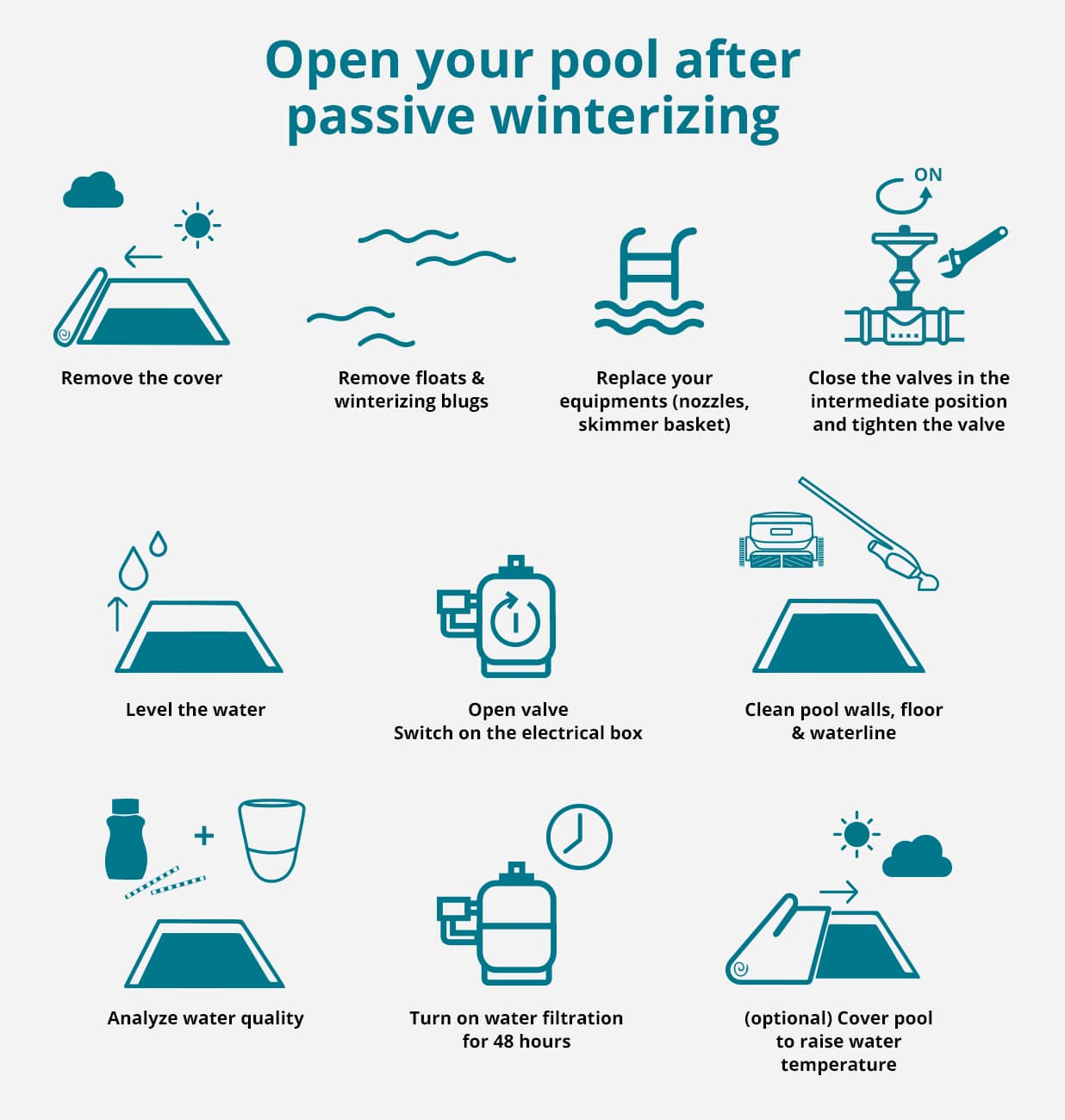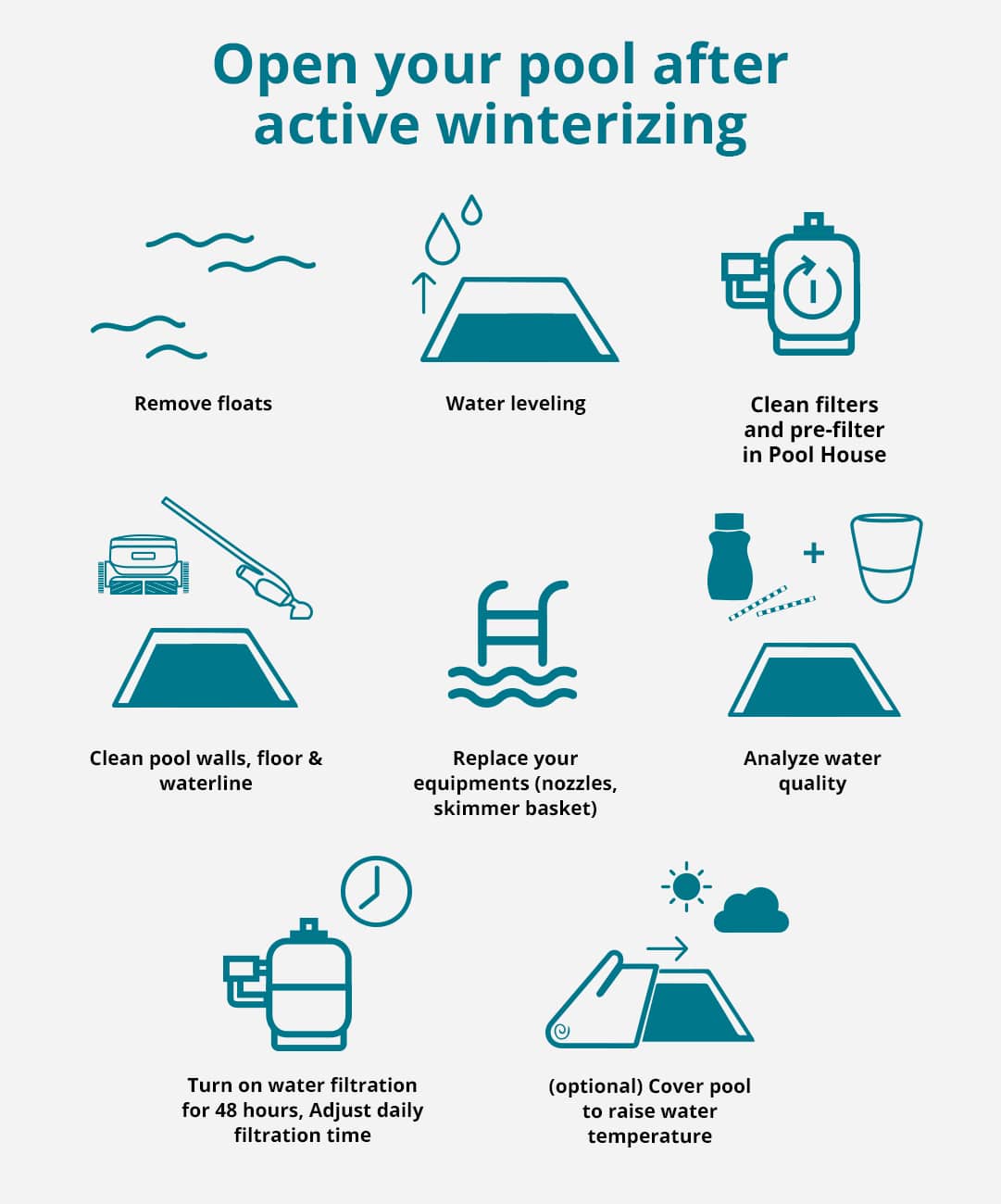It's time to get your pool up and running again when the warm weather arrives and the water temperature is between 12°c and 15°C. What to do after passive or active wintering? Which treatments to use? How do clean filters? This step is very important to avoid the appearance of algae and micro-organisms throughout the season. Follow our step-by-step tips to start the season with peace of mind!

To determine when to restart your pool, the water temperature should be between 12°C and 15°C, which is generally between March and April.Forsalt chlorinator pools, the water temperature must reach 15°C to avoid damaging the electrodes.
It may be a tempting idea to put off starting up your pool in order to save on electricity or maintenance costs, but it's a bad idea! In fact, the rise in water temperature leads to the development of bacteria and, in particular, the appearance of green algae. You run the risk of having to treat these algae with costly products to restore clear, healthy water, in addition to the time spent scrubbing the walls. To avoid this stress at the start of the season, keep an eye on the water temperature and summerize your pool without delay.
On the other hand, restarting too early in the season can put your equipment at risk if the frost returns.
The steps involved in restarting your pool after active or passive wintering are different. It is therefore imperative to adapt the process.

Cover: clean and dry the cover before storing it in a dry place
Now that the risk of frost has passed, you can take out the gizmos, floats and wintering plugs, clean them and put them away until the end of the season.
Refit filtration accessories such as filter socks and nozzles, then screw adjustable jets into the outlets.
Open the valves in the intermediate position and retighten the unions on the valves, filter and pump.
In order for the pump to operate, the water level must be raised to about ¾ of the skimmers.
It's important to clean and check your filtration system so you can enjoy peace of mind all season long. To do this, close the drain plug on your filter. Then replace the drain plug on your filtration pump. Fill the pre-filter with water and tighten the lid. Thirdly, open the valves in the equipment room and set the valve to filtration. Finally, switch on the electrical box and restart your equipment.
To begin with, descale and desand the filter. To find out how to clean your filter, read this article. If you have a cartridge filter, put in new cartridges.
Now it's the pool's turn. Using your usual equipment (robot, broom, brush, landing net), clean all the walls, the water line and the surface of the water to remove all residues. If you have a tiled pool, now is the time to thoroughly clean your tiles with a high-pressure jet such as a Kärcher. It's also important to clean the area around your pool (coping stones, decking), which can be a source of water pollution, not forgetting to clean the cover, paying particular attention to the gaps between the slats. Once the pool is clean, finish off with the summer accessories (ladder, diving board, etc.).
Once the water in your pond has been levelled and filtered for oxygenation, it's time to analyze the water quality. You need to test the pH, ORP (disinfectant level) and TH (water hardness). The first objective is to achieve a balanced pH (7.2 for chlorine treatment) and 7.5 for bromine treatment, by adding pH+ or pH - in small quantities. Make sure you distribute the product evenly throughout the pool, for faster action.
Some professionals recommend systematic shock treatment, even if you've used a winterizing product. It's true that shock treatment is radical in killing bacteria, but it's a powerful chemical that comes at a cost. It's not an obligation, therefore, when passive wintering has been carried out according to the rules of the art, and it allows you to consume products more responsibly.
If you've winterized ICO, here's how to get your ICO Pool up and running again. Otherwise, don't hesitate to discover our ICO Pool connected water analyzer.
Run your filtration for about 48 hours to ensure that your water is healthy and crystal clear. Then, readjust the daily filtration time according to the temperature of your pool.
If the outside temperatures are still cool, don't hesitate to cover your pool: this step is not compulsory, but it also protects the water from external pollution such as pollen, insects...
During your active wintering period, you should have continued to filter your pool water for a few hours a day and treated it regularly to maintain its quality. Now it's time to resume more active filtration after a good cleaning.

If you have used equipment such as a winter cover or antifreeze floats, clean and dry them before storing them for the season in a clean place.
If necessary, adjust the water level up to ¾ of the skimmers. To keep your water healthy, we recommend changing 1/3 of your pool water every year to eliminate micro-organisms and traces of chemicals. But if you've been cleaning your pool regularly throughout the winter, this isn't necessary.
In the Pool House, change filters (cartridge, sand, etc.) and pre-filter if necessary, to guarantee the quality of your filtration system for the summer.
Start by cleaning all the walls, the water line and the water surface to remove all residues. Don't forget to clean the area around your pool that could contaminate the water, as well as the roller shutter, insisting on cleaning between the slats.
Once the pool is clean, put back the accessories (ladders, diving board,...)
Now it's time to measure your pool's water quality. Here are the parameters to analyze:
Shock treatment of your pool after active wintering is only necessary in the event of green water or the presence of green algae. It rapidly destroys organisms, fungi and bacteria. If this is the case, make sure you distribute the product evenly throughout the pool, so that it acts quickly and effectively. If you have an automatic electrolysis treatment system, adjust the salt level before restarting the unit.
Run your filtration for about 48 hours to ensure that your water is healthy and crystal clear. Then, readjust the daily filtration time according to the temperature of your pool.
If you've winterized ICO, here's how to get your ICO Pool up and running again. Otherwise, don't hesitate to discover our ICO Pool connected water analyzer.
If the outside temperature is still cool, you can cover your pond with a bubble cover or your roller shutter. This also prevents the water from cooling down too much at night, allowing it to gradually rise in temperature. This allows the water to warm up slowly, while protecting water quality.
If you have winterized your ICO Pool, it also needs to be restarted in spring. See our support page for instructions on how to reactivate ICO ,calibrate the sensors and start water analysis for the season.
| Cookie | Duration | Description |
|---|---|---|
| cookielawinfo-checkbox-analytics | 11 months | This cookie is set by GDPR Cookie Consent plugin. The cookie is used to store the user consent for the cookies in the category "Analytics". |
| cookielawinfo-checkbox-functional | 11 months | The cookie is set by GDPR cookie consent to record the user consent for the cookies in the category "Functional". |
| cookielawinfo-checkbox-necessary | 11 months | This cookie is set by GDPR Cookie Consent plugin. The cookies is used to store the user consent for the cookies in the category "Necessary". |
| cookielawinfo-checkbox-others | 11 months | This cookie is set by GDPR Cookie Consent plugin. The cookie is used to store the user consent for the cookies in the category "Other. |
| cookielawinfo-checkbox-performance | 11 months | This cookie is set by GDPR Cookie Consent plugin. The cookie is used to store the user consent for the cookies in the category "Performance". |
| viewed_cookie_policy | 11 months | The cookie is set by the GDPR Cookie Consent plugin and is used to store whether or not user has consented to the use of cookies. It does not store any personal data. |